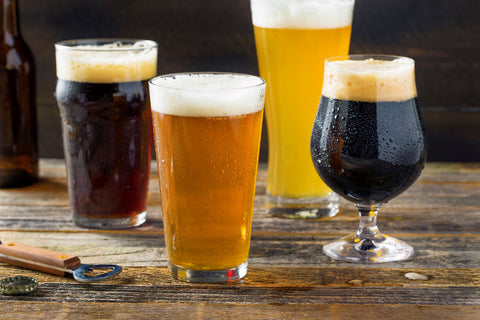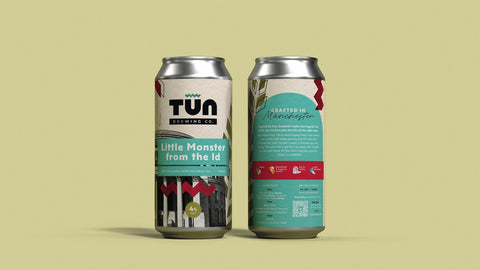Craft Beer is everywhere nowadays, but a question you may have wondered is: What exactly is it? What makes a beer, a craft beer?
The main characteristic of craft beer is that it is produced by small, independent breweries, which stands in contrast to mass-produced beer made by large industrial brewers. However, many other differences span how the beer is brewed, what goes into it, the scale of production, the variety of flavours, and, interestingly, even the philosophy behind the business. Craft beer has become a movement.
Let’s go into the attributes of craft beer in a little more detail, and look at where it came from to where it is now.

Brewing Techniques
What makes craft beer preferable to some is that craft brewers tend to use traditional and hands-on brewing methods, often in small batches. They allow each stage of brewing (mashing, fermentation, conditioning) the necessary time to develop complexity, rather than rushing the process. Because batches are smaller, brewers can make precise adjustments during brewing, such as tweaking temperatures, adding hops, or fine-tuning timings, to achieve a desired flavour profile. This makes the process more artisanal, hence the name craft beer.
 In contrast, mass-produced beer is typically brewed with highly automated, high-volume methods designed for efficiency and consistency. Productivity and reproducibility are paramount in mass production, whereas craft brewers are willing to trade some of this for creativity.
In contrast, mass-produced beer is typically brewed with highly automated, high-volume methods designed for efficiency and consistency. Productivity and reproducibility are paramount in mass production, whereas craft brewers are willing to trade some of this for creativity.
Ingredients
Craft brewers generally prioritise high-quality, natural ingredients and often stick to the traditional core four: water, malted barley (and sometimes other speciality grains), hops, and yeast. Malts and hops are chosen for their flavour and aroma contributions, not just their yield or cost. It is also typical for ingredients to be locally sourced for a regional touch. Many craft beers also incorporate innovative ingredients, such as fruits, spices, coffee,and chocolate, etc to create novel styles, which can be attractive to consumers wanting to try something different. Artificial additives or preservatives are also usually avoided, making craft beer a potentially healthier option.

Large industrial breweries often use adjuncts (unmalted grains or other fermentable sugars like rice, corn, or sugar) alongside malted barley. These adjuncts produce a lighter-bodied, milder-flavoured beer and reduce cost. In short, craft brews favour bold and distinctive flavour over lowering costs and pleasing the crowd!
Flavour Diversity
That leads us to the immense variety of flavours available of craft beers, which is perhaps the most exciting difference for consumers. Craft beer is celebrated for its wide array of styles and robust flavours.
The hallmark of craft brewers is innovation and variety. Some craft breweries resurrect historic styles (such as porters, stouts, saisons, and goses), others put creative twists on traditional recipes, and still others invent new styles with no precedent. Seasonal and limited-edition beers are common, introducing flavours like pumpkin spice in autumn, fruit-infused sours in summer, or spiced winter ales. No flavour combination is off-limits! This breadth of imagination caters to beer drinkers seeking new experiences. They are not trying to please everyone with a single beer; instead, they’re pleasing smaller groups of fans with bold choices.

Production Scale
One of the most apparent differences is the scale of production. Craft breweries are, by definition, small producers relative to the brewing giants. Many are local microbreweries that brew only a few thousand barrels annually, or even tiny nanobreweries that produce beer one small batch at a time. Craft breweries often serve a regional or even neighbourhood market.

Kegged Over Cask
Craft beer is more often associated with kegged beer than with cask ale, a distinction that is due to both practical and cultural factors. Kegged beer is stored under pressure in sealed stainless-steel kegs and served using carbon dioxide or mixed-gas systems, providing greater stability, shelf life, and consistency – qualities that align with the experimental and distribution-focused nature of many craft breweries. Kegs enable brewers to craft bold, hop-forward styles, high-carbonation beers, and innovative seasonal releases, while ensuring those flavours hold up during transport and storage. In contrast, cask ale is traditionally served from a cask without added carbonation and conditioned naturally in the vessel. Many craft brewers experiment with cask-conditioned offerings, although the modern craft beer movement has chosen the keg format as its primary vehicle, as it complements the more assertive and varied styles that define craft brewing.

Business Philosophy
Beyond the beer itself, craft brewers and their larger counterparts, such as big brewers, have distinctly different business philosophies and cultures. Craft breweries typically pride themselves on being independent, community-oriented, and driven by passion. Many craft breweries start as a labour of love by people who are beer enthusiasts first and businesspeople second. As we have discussed, they are more about quality over quantity and innovation over mass appeal. Craft brewers often talk about brewing the kind of beer they love to drink and sharing that passion with their local community. Indeed, craft breweries tend to be deeply embedded in their local communities – supporting local events, collaborating with nearby farms or artisans, and serving as or becoming community gathering spots. There’s also an ethos of collaboration among craft brewers, rather than pure competition, where they share ideas and knowledge. Because they aren’t beholden to giant corporate structures or shareholders, craft brewery owners are more able to stick to their principles (for instance, some refuse to use certain ingredients or processes that they feel compromise the beer). The philosophy is often encapsulated in the branding of craft beer, which highlights stories, unique artwork, quirky names, and a general sense of fun and experimentation.
A key philosophical divide is independence. Craft brewers cherish it and tend to avoid “selling out.” The “indie” spirit is a massive part of craft beer culture – it’s about David vs. Goliath, the little guys preserving brewing diversity against the corporate giants.
Craft breweries also tend to be more transparent about their ingredients and process (many invite customers for tours and openly discuss recipes), aligning with a philosophy of authenticity.
In summary, craft brewers run on passion, independence, and community connection, operating like artisanal entrepreneurs.

A Short History of Craft Beer
● 1970s – CAMRA and the Real Ale Revival
The modern UK craft beer story starts in 1971 with the founding of the Campaign for Real Ale (CAMRA). At the time, British beer was dominated by a few large brewers producing filtered and pasteurised keg beers. CAMRA campaigned for the preservation of traditional cask-conditioned ale and local brewing practices, sparking renewed interest in flavourful, unfiltered beer.
● 1980s – The First Microbreweries
Inspired by this revival, small “microbreweries” began opening across Britain. Pioneers like Selby Brewery (1972) and Holt’s in Manchester set early examples, but the real boom started in the 1980s. These breweries focused on traditional recipes, hand-crafted methods, and serving beer close to where it was brewed. The term “microbrewery” became a catchphrase for independence and small-scale operations.
● 1990s – Brewpubs and Growth
By the 1990s, microbreweries and brewpubs had become more established. Big brands still dominated the UK beer market, but a growing number of enthusiasts sought out characterful ales. The groundwork was laid for what would later be recognised as the “craft” movement.
● 2000s – The Rise of ‘Craft’
In the 2000s, a new wave of UK brewers drew inspiration from both American craft beer (particularly hop-forward IPAs) and British traditions. Breweries like Meantime (founded 1999), Thornbridge (2005), and BrewDog (2007) pushed bolder flavours and modern branding. Their success made “craft beer” a household phrase in the UK for the first time.
● 2010s – Boom and Mainstreaming
The 2010s saw explosive growth. Hundreds of small, independent breweries have opened across the UK, offering a range of styles, from hazy IPAs to sour beers. Supermarkets and pubs began stocking craft options alongside mainstream lagers, and festivals and taprooms multiplied. By the mid-2010s, the UK had one of the most vibrant craft beer scenes in the world, second only to the US.
Which leads us to today, where craft beer is an integral part of the beer industry, offering consumers and communities an alternative to mass-market lagers. Its history is one of passionate individuals reviving and reinventing beer styles, and of small businesses challenging the industry giants. The movement has vastly expanded the beer universe – from a few similar-tasting beers mid-century to today’s almost endless variety of ales and lagers. In doing so, craft brewers and their customers have transformed global beer markets, marking the end of monotony and demonstrating that beer can be as diverse and artisanal as wine or food. What started as a niche rebellion against “the usual” has evolved into a worldwide phenomenon. And while craft beer continues to grow, with new generations of brewers and drinkers, its core differentiation from mass-produced beer – in techniques, ingredients, scale, flavour, and philosophy – remains as stark and vital as ever.







